The Longest Photographic Exposures in History
 Tuesday, July 20, 2010 at 12:18PM
Tuesday, July 20, 2010 at 12:18PM A friend sent me a link to this photo here today. I have seen it a few times before and it was always (WRONGLY) claimed as being the longest exposure in photographic history. It was taken with a pinhole camera over a period of 6 months by a photographer called Justin Quinnell. It shows the traces of the sun over Bristol's suspension bridge during that half year period. Which is impressive and beautiful. BUT IT IS NOT THE LONGEST EXPOSURE.
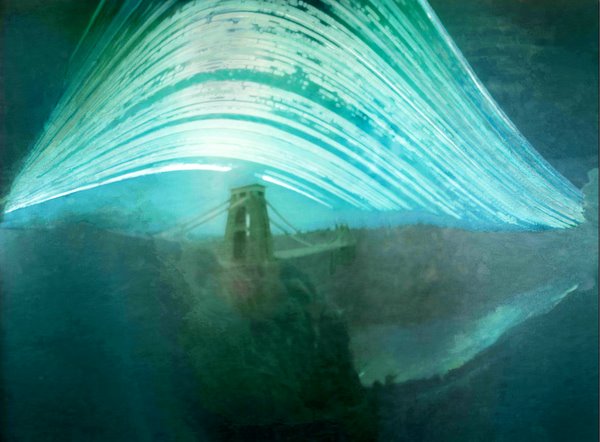

The German photography artist Michael Wesely has created even longer exposures. Using large format cameras (4x5 inches) he captured the light of his objects for up to 3 years in monochrome or colour.
In 2001 he was invited by the Museum of Modern Art in New York to use his unique technique to record the re-development of their building. He set up eight cameras in four different corners and photographed the destruction and re-building of the MoMa until 2004 - leaving the shutter open for up to 34 months!
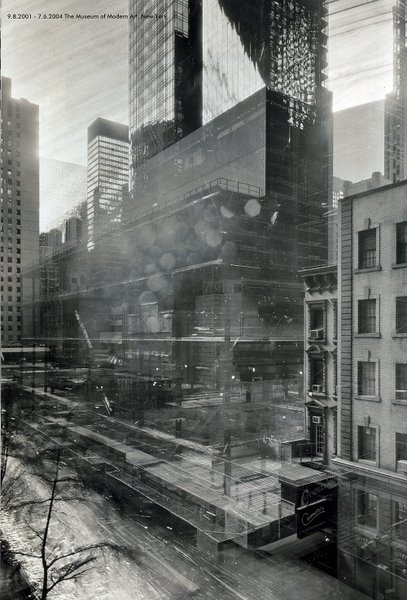

The sun traces in the sky give the images a beautiful, painting-like feeling. To me it is very surreal to see the movement of the sun - or more precisely the movement of the earth around the sun in such a way.
The photo below was taken over almost 14 months at the Leipziger Platz in Berlin - which at the time together with the Potsdamer Platz formed one of the biggest construction sites in the world.

I find incredible that you can actually see the passing of time. The older parts of the building that were exposed the longest appear darker and clearer. While the newer parts seem more ghost like. More than 2 years took it Michael to create this incredible time incapsulation at the Potsdamer Platz in Berlin (below).
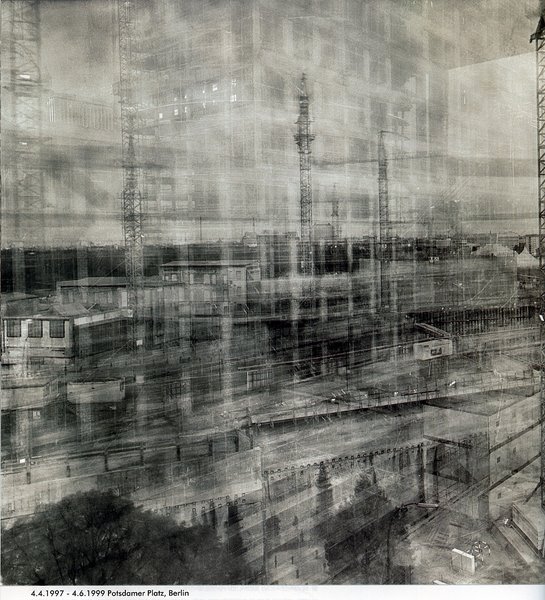
Wesely claims that he could do exposures almost indefinitely - up to 40 years! Now that's something I would love to see one day.
Here is another image he created. It is a one-year exposure of an office which he took from 29 July 1996 to 29 July 1997.

Here is another one of his mesmerising creations. I don't know exactly how long he exposed it, but I think it is totally beautiful too. The life and death of a bunch of flowers.
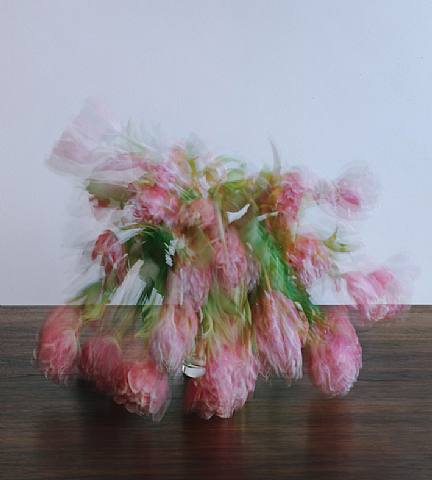
If you are interested in his photographs you can buy his book he published a while ago.
OPEN SHUTTER by Michael Wesely
 itchy i
itchy i
NEW! UPDATE! PLEASE READ ON!
The tremendous popularity of this article with more than half a million (!) clicks in one month inspired me to contact the artist Michael Wesely himself.
I felt there were questions by readers which I couldn't answer correctly without talking to Michael. And I also wanted to tell him how much his worked was loved and how many people saw it as an inspiration for their own works and lives.
From the many comments I learned, that many of you were astonished by the beauty of the images but also by the technical aspects of their making. The fact that the light fell for up to 3 years onto the same negative strip without over-exposing seemed just too unbelievable.
But Michael confirmed that he indeed created continuous, uninterrupted exposures over those long periods of time. This can be seen through the long light lines in the sky, which were created by the movement of the sun across the sky during those many months.
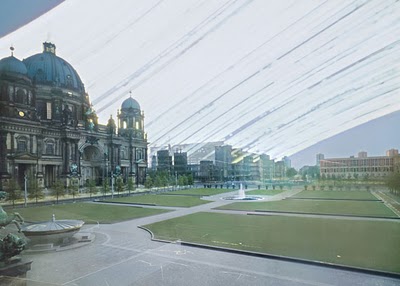 Michael Wesely, Palast der Republik, Berlin (28.6.2006 - 19.12.2008), © Michael Wesely,
Michael Wesely, Palast der Republik, Berlin (28.6.2006 - 19.12.2008), © Michael Wesely,
Michael wanted to highlight that he also sees those lines as an indicator for something else. He told me that "the lines in the sky put our existence, us, our planet into context with the Dance of the Universe, which coexists on an entirely different time scale [from us]."
His works were truly a hard and long labour of love. The so called reciprocity failure or Schwarzschild effect means one can't simply pre-calculate extreme long exposures.
It took Michael months and months of experimenting to make sure the negatives weren't going to be over-exposed. He said, if you'd planned to expose for a year you would have to do an exposure of 6 months, and 3 months beforehand and so on. You would have to collect a lot of data and find solutions for a lot of detail problems.
Michael started with pin-hole cameras (1988-1994) but then moved on to use large format cameras (4x5 inches) as these would provide images with a much higher amount of details.
And this is what he was after - details. The technical challenge was never his main driving force. His goal was to capture information that told about our daily lives: the forgetting, remembering, regenerating and the transitions - a general focus point of Michael's works.
 © Michael Wesely
© Michael Wesely
As you can tell from the images certain details are hardly visible and only become 'alive' when you get close and spend some time discovering them - something that is only really possible when the images are exhibited as large prints in a gallery.
I really loved what Michael pointed out about the creation of the images. During the long exposure times the pictures constantly destroyed themselves, by putting layers and layers of new details on top each other.
Just when one detail had burned into the negative it was erased or overshadowed by another detail. In his eyes this constant change and destruction is something that really stands for the state of our society. "The moment is fading, all that remaines is the permanent overlapping of movements of all kinds, political or personal. The technologies of our times fuel this fire of restless 'Online-Existence'. One day computers won't have an on- or off-button anymore. We will always be online."
I agree with Michael. We live in a world of constant transition - where even buildings are not constructed to last forever but to be easily destructable when not needed anymore. Or where consumer products are desgined to destroy themselves after 2 years so you have to buy a new one. I have even seen a whole country - the country I was born in - East Germany (German Democratic Republic) - vanish in a blink of an eye. All it stood for, all that a whole generation loved or hated was gone within one year.
It shows that the only thing constant in our times seems to be: Change. Which I think - can be seen as a bad thing - when one misses a save haven where one can anchor his or her heart and soul in stormy times. Or when mankind doesn't take the time needed to learn from the now to avoid mistakes in the future.
But there is also something great about this constant change and transition. It seems to follow something deeply universal - something so powerful that nobody can stop it. Something that makes life so interesting and unpredictable - and very often worth living.
When looking at Michael's work I can find all these elements frozen into images that will never seize to amaze me.
If you are interested in his works then check out his new book TIME WORKS which was just published by Schirmer/Mosel Verlag. It is an eclectic mix of Michael's creations from 1992 until now.
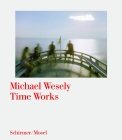
References (71)
-
 Response: Pariuri Sportivewell worth the read. thank you very much for taking the time to share with those who are starting on the subject. greetings
Response: Pariuri Sportivewell worth the read. thank you very much for taking the time to share with those who are starting on the subject. greetings -
 Le light painting est � la mode. Cette technique, cr��e par le photographe Man Ray, consiste � r�aliser des dessins en prenant des photos en pause longue pendant qu'un objet lumineux (torche, �cran de smartphone, etc...) bouge devant l'objectif pour...
Le light painting est � la mode. Cette technique, cr��e par le photographe Man Ray, consiste � r�aliser des dessins en prenant des photos en pause longue pendant qu'un objet lumineux (torche, �cran de smartphone, etc...) bouge devant l'objectif pour... -
 Response: PhylisThe Longest Photographic Exposures in History - The Latest - itchy i
Response: PhylisThe Longest Photographic Exposures in History - The Latest - itchy i -
 Response: aruba all inclusive vacations packagesThe Longest Photographic Exposures in History - The Latest - itchy i
Response: aruba all inclusive vacations packagesThe Longest Photographic Exposures in History - The Latest - itchy i -
 Response: kyle
Response: kyle -
 Response: buy beats Online exclusive rightsThe Longest Photographic Exposures in History - The Latest - itchy i
Response: buy beats Online exclusive rightsThe Longest Photographic Exposures in History - The Latest - itchy i -
 Response: generalThe Longest Photographic Exposures in History - The Latest - itchy i
Response: generalThe Longest Photographic Exposures in History - The Latest - itchy i -
 Response: Highly recommended Web-siteThe Longest Photographic Exposures in History - The Latest - itchy i
Response: Highly recommended Web-siteThe Longest Photographic Exposures in History - The Latest - itchy i -
 Response: maxdameon.wordpress.comThe Longest Photographic Exposures in History - The Latest - itchy i
Response: maxdameon.wordpress.comThe Longest Photographic Exposures in History - The Latest - itchy i -
 Response: VideoThe Longest Photographic Exposures in History - The Latest - itchy i
Response: VideoThe Longest Photographic Exposures in History - The Latest - itchy i -
 Response: get viewsThe Longest Photographic Exposures in History - The Latest - itchy i
Response: get viewsThe Longest Photographic Exposures in History - The Latest - itchy i -
 Response: beats cheapOn wanting to be more relatable
Response: beats cheapOn wanting to be more relatable -
 Response: 0900Geniesse mittels 0900 Nummer entspannte Stunden am Telefon
Response: 0900Geniesse mittels 0900 Nummer entspannte Stunden am Telefon -
 Response: low price tv wall mounts
Response: low price tv wall mounts -
 Response: 16 seater mini bus readingThe Longest Photographic Exposures in History - The Latest - itchy i
Response: 16 seater mini bus readingThe Longest Photographic Exposures in History - The Latest - itchy i -
 Response: 16 seater mini bus readingThe Longest Photographic Exposures in History - The Latest - itchy i
Response: 16 seater mini bus readingThe Longest Photographic Exposures in History - The Latest - itchy i -
 Response: mold inspection
Response: mold inspection -
 Response: personal injury attorney st petersburg
Response: personal injury attorney st petersburg -
 Response: flood damage
Response: flood damage -
 Response: water damage
Response: water damage -
 Response: lead gen for restoration
Response: lead gen for restoration -
 Response: mold removal company
Response: mold removal company -
 Response: dark mold removal
Response: dark mold removal -
 Response: water damage cleaners
Response: water damage cleaners -
 Response: jack wolfskin jackeFor this article. I think the authors write very well. Content lively and interesting. Details are as follows:jack wolfskin jacke or jack wolfskin jacke Hollister Online Shop
Response: jack wolfskin jackeFor this article. I think the authors write very well. Content lively and interesting. Details are as follows:jack wolfskin jacke or jack wolfskin jacke Hollister Online Shop -
 Response: fun run hackThe Longest Photographic Exposures in History - The Latest - itchy i
Response: fun run hackThe Longest Photographic Exposures in History - The Latest - itchy i -
 Response: Indianapolis Laser Hair RemovalThe Longest Photographic Exposures in History - The Latest - itchy i
Response: Indianapolis Laser Hair RemovalThe Longest Photographic Exposures in History - The Latest - itchy i -
 Response: kitchen remodel woodland hills
Response: kitchen remodel woodland hills -
 Response: futuristic hip hopThe Longest Photographic Exposures in History - The Latest - itchy i
Response: futuristic hip hopThe Longest Photographic Exposures in History - The Latest - itchy i -
 Response: old school new body pdfI found a great...
Response: old school new body pdfI found a great... -
 Response: Frank DellaglioThe Longest Photographic Exposures in History - The Latest - itchy i
Response: Frank DellaglioThe Longest Photographic Exposures in History - The Latest - itchy i -
 Response: Melissa and Doug PianoThe Longest Photographic Exposures in History - The Latest - itchy i
Response: Melissa and Doug PianoThe Longest Photographic Exposures in History - The Latest - itchy i -
 Response: Beyerdynamic Custom One ProThe Longest Photographic Exposures in History - The Latest - itchy i
Response: Beyerdynamic Custom One ProThe Longest Photographic Exposures in History - The Latest - itchy i -
 Response: wireless gaming headsetThe Longest Photographic Exposures in History - The Latest - itchy i
Response: wireless gaming headsetThe Longest Photographic Exposures in History - The Latest - itchy i -
 Response: best Denver DUI lawyerThe Longest Photographic Exposures in History - The Latest - itchy i
Response: best Denver DUI lawyerThe Longest Photographic Exposures in History - The Latest - itchy i -
 Response: best flowers onlineThe Longest Photographic Exposures in History - The Latest - itchy i
Response: best flowers onlineThe Longest Photographic Exposures in History - The Latest - itchy i -
 Response: bestdivorce lawyer West BendThe Longest Photographic Exposures in History - The Latest - itchy i
Response: bestdivorce lawyer West BendThe Longest Photographic Exposures in History - The Latest - itchy i -
 Response: diadora soccer cleatsThe Longest Photographic Exposures in History - The Latest - itchy i
Response: diadora soccer cleatsThe Longest Photographic Exposures in History - The Latest - itchy i -
 Response: Chapter 7 and Chapter 13The Longest Photographic Exposures in History - The Latest - itchy i
Response: Chapter 7 and Chapter 13The Longest Photographic Exposures in History - The Latest - itchy i -
 Response: Best Gaithersburg SEO CompanyThe Longest Photographic Exposures in History - The Latest - itchy i
Response: Best Gaithersburg SEO CompanyThe Longest Photographic Exposures in History - The Latest - itchy i -
 Response: cheap golf packageThe Longest Photographic Exposures in History - The Latest - itchy i
Response: cheap golf packageThe Longest Photographic Exposures in History - The Latest - itchy i -
 Response: order flowers nowThe Longest Photographic Exposures in History - The Latest - itchy i
Response: order flowers nowThe Longest Photographic Exposures in History - The Latest - itchy i -
 Response: googleThe Longest Photographic Exposures in History - The Latest - itchy i
Response: googleThe Longest Photographic Exposures in History - The Latest - itchy i -
 Response: top Colorado DUI lawyerThe Longest Photographic Exposures in History - The Latest - itchy i
Response: top Colorado DUI lawyerThe Longest Photographic Exposures in History - The Latest - itchy i -
 Response: clickThe Longest Photographic Exposures in History - The Latest - itchy i
Response: clickThe Longest Photographic Exposures in History - The Latest - itchy i -
 Response: check this outThe Longest Photographic Exposures in History - The Latest - itchy i
Response: check this outThe Longest Photographic Exposures in History - The Latest - itchy i -
 Response: visitThe Longest Photographic Exposures in History - The Latest - itchy i
Response: visitThe Longest Photographic Exposures in History - The Latest - itchy i -
 Response: Garage doors Tarzana
Response: Garage doors Tarzana -
 Response: Garage door Van Nuys
Response: Garage door Van Nuys -
 Response: kitchen remodeling los angeles
Response: kitchen remodeling los angeles -
 Response: palio.com.auThe Longest Photographic Exposures in History - The Latest - itchy i
Response: palio.com.auThe Longest Photographic Exposures in History - The Latest - itchy i -
 Response: advertising musicThe Longest Photographic Exposures in History - The Latest - itchy i
Response: advertising musicThe Longest Photographic Exposures in History - The Latest - itchy i -
 Response: deal cruiseThe Longest Photographic Exposures in History - The Latest - itchy i
Response: deal cruiseThe Longest Photographic Exposures in History - The Latest - itchy i -
 Response: General contractor woodland hills[...]The Longest Photographic Exposures in History - The Latest - itchy i[...]
Response: General contractor woodland hills[...]The Longest Photographic Exposures in History - The Latest - itchy i[...] -
 Response: give adviceThe Longest Photographic Exposures in History - The Latest - itchy i
Response: give adviceThe Longest Photographic Exposures in History - The Latest - itchy i -
 Response: discover thisThe Longest Photographic Exposures in History - The Latest - itchy i
Response: discover thisThe Longest Photographic Exposures in History - The Latest - itchy i -
 Response: tahliasmythe.blogspot.mxThe Longest Photographic Exposures in History - The Latest - itchy i
Response: tahliasmythe.blogspot.mxThe Longest Photographic Exposures in History - The Latest - itchy i -
 Response: river rock bathroom tileThe Longest Photographic Exposures in History - The Latest - itchy i
Response: river rock bathroom tileThe Longest Photographic Exposures in History - The Latest - itchy i -
 Response: resume service lancaster paThe Longest Photographic Exposures in History - The Latest - itchy i
Response: resume service lancaster paThe Longest Photographic Exposures in History - The Latest - itchy i -
 Response: machine a laver le linge casinoThe Longest Photographic Exposures in History - The Latest - itchy i
Response: machine a laver le linge casinoThe Longest Photographic Exposures in History - The Latest - itchy i -
 Response: CellogicaThe Longest Photographic Exposures in History - The Latest - itchy i
Response: CellogicaThe Longest Photographic Exposures in History - The Latest - itchy i -
 Response: click the next webpageI found a great...
Response: click the next webpageI found a great... -
 Response: prestamos rapidos con asnef
Response: prestamos rapidos con asnef -
 Response: click
Response: click -
 Response: Calculatoare ieftine
Response: Calculatoare ieftine -
 Response: Calculatoare second hand
Response: Calculatoare second hand -
 Response: for more info click here
Response: for more info click here -
 Response: aura magic glow
Response: aura magic glow -
 Response: closing ceremony in olympics
Response: closing ceremony in olympics -
 Response: aura glow cream wajah
Response: aura glow cream wajah -
 Response: pemutih wajah aura glow
Response: pemutih wajah aura glow

Reader Comments (108)
this is haunting
I also remember seeing that picture that wrongly claimed to be the longest exposure. Thank you for setting this straight, because I don't even like that picture.
gorgeous. love them.
OH MY GOD. This is a cause to celebrate; inspiration for the rest of us to step up our game (in anything and everything we do).
Sarah - I am glad you see it in the exact same ways as me. It is so inspiring to see someone going through such an incredible amount of effort to get one photo. That's why it was so important for me to give Michael the credit he deserves. :)
But is this really the same thing? The first photo (with it's 6 month exposure) is made with a pinhole camera, which naturally has no shutter and thus the pinhole is open the whole time (6 month).
Wheras it says here:
Hi Mike,
yes it is the same technique. Each image is the result of an ongoing exposure of the same piece of film which was held in a pin hole camera.
He basically opened the shutter (hole) and then left it open for up to 3 years. The light fell for the whole time onto the same frame of the film. That's why you can see the long bow-stripes of the sun - as it "moved" across the sky.
I have slightly altered my wording in the main text - to make sure it is a bit clearer from now on.
Thanks for reading! :)
this is awesome...loved the berlin pic...too good
Hi Mike:
Excellent results from an extremely "old technology". How'bout that? Imagine, someone actually using film and real talent to create art that will live forever. Take that, digital!
Before you get your dander up...I am not a digital hater. I am a person who appreciates those who have studied the craft of creating images and the art of painting with, and controlling light to the point that the rest of us can only dream that we may someday create an image that even is close. All of these images herein were created by true masters. Gentlemen, I salute you.
I still feel though that you are opening a debate with "longest exposure" VS " longest continuous exposure" The original piece of the Bristol Bridge by Justin Quinnel is beautiful AND one of the longest "continuous exposures" ever recorded. You can see the true tracking of the sun as evidence of his leaving the pinhole open constantly and continuously. On the other hand the images by Michael Wisely could be more in line with the photographic technique (movie technique), of pixilation, although the difference is that the images are recorded on one single film plane. I suppose that by definition this makes them the true "longest exposures" ....
Back in the "old days" of KODACHROME ( c'mon Kodak, bring it back!!!!), images of fireworks were made with a tripod mounted camera and covering and uncovering the lenscap with each burst.
Either way these are some of the finest long exposures I have ever laid eyes on, and thanks very much for sharing them. Thanks also for the opportunity to post a comment.
Take Care, Tim
Very nice post, i like the focus and general direction of the post, great insight.
thanks
The library one is my favorite.
3 years? Amazing.
Wow, that's a truly wonderful work of art. Thanks for posting this.
Pure Awesomeness.
This is THE idea of the century ! How to use one of the oldest human invention to capture "time traveling" and effects.
Lumiere Brothers would have trust and love such work !
You might like to check out http://www.solargraphy.com for more on this way of image making
I'm absolutely in love with a couple of these images. I so miss using film, and trying simple but fun experiments with light and the camera. I forget about the art of it sometimes when I get caught up in timelines and the ease of digital cameras. These are great and a great inspiration!
Astonishing what a human can do....Love it love it..
that's incredible, simply incredible
I appreciate good photography as much as the next person and I don't mean to burst any bubbles, but seriously... all these people did was take off a lenscap and walk away for months or years at a time. When it came time to process the film, they wound up with something kinda cool.
I'm definitely not anti-analog. I work in digital on a daily basis and a lot of times, it's a flawless bore. Perhaps it's the size of the images here, but I'm not seeing enough detail to make me think "Wow... these are really important and artful." The art in this process seems to me to be that of any other photo... finding the ideal location for good lighting and composition. The whole "time travel" aspect could have been gotten by setting up a digital camera on a tripod, shooting an image daily and piecing it all together in Photoshop (which has been done to death).
I get the whole rediscovered tech thing and the appeal of the analog process, but I guess I'm just not that impressed with the end result. Maybe I'm missing something, so if you can enlighten me, please do... I want to be as amazed as others commenting here seem to be, but I'm just not.
I remember seeing pictures taken by Mr. Wesely in cinemas, exposure time being through the whole movie. Those had a really eerie quality, the only light coming from the screen and, strangely, no people to see in the seats.
Unfortunately, his website doesn't have pictures anymore... :(